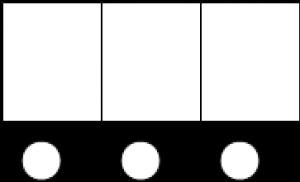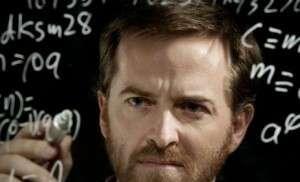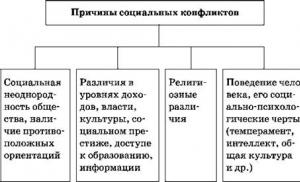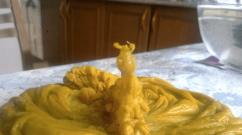Who owns the Apple company. Acquisition of companies and appearance in Russia
Perhaps today the overwhelming majority of people, when it comes to an apple, will first of all think not about a fruit, but about the largest corporation, a well-known brand, a technology giant - about the Apple corporation.
Yes, indeed, it is, people who do not know about the existence of the products of this American company and do not dream of a laptop, tablet or smartphone made by Apple, probably do not exist today.
But the history of the modern giant began with an ordinary garage and Apple founder, simple guy Steve Jobs.
Steve's childhood and adolescence
Steve was born in 1955 and his parents were students who were not even married. Given the difficulties of life, problems with parents and many other factors, the biological parents were forced to give the boy up for adoption. This is how the future billionaire ended up in the family of Paul and Carla Jobs, people whom he called his real parents in the future.
It was Paul who introduced his son to the basics of electronics in childhood, which attracted the boy very much and gave him the main hobby and passion for his entire subsequent life.
Jobs almost skipped elementary school because of his extraordinary knowledge. And thanks to an offer from the director, I slipped through several classes, going straight to high school.
Friendship with Steve Wozniak
At fifteen, Steve developed a friendship with one of his classmates at the new school, whose name was Bill Fernandez. He, like Steve, was interested in electronics, but this acquaintance was such a significant moment not because of this. Bill had a friend with a passion for technology and innovation, almost stronger than Jobs himself. And it was Steve Wozniak. Over time, Bill introduced the two namesakes and this made, subsequently, their best friends.
Apple's iOS is
Cool!Sucks
Crucial moment
In 1971, a turning point occurred in Jobs's life, which made him understand that electronics can bring in quite serious money, not just be some kind of hobby, hobby.
All this happened because of a very interesting story, which, by the way, became the first business project of two Steves. Then the guys were able to invent the so-called "Blue Box", which mimicked the sounds of the tone signal of payphones. Thanks to the use of the product, it was possible to make completely free calls from payphones to any part of the world.
The guys very quickly realized that due to such a device they could make good money and soon began selling them to their peers for $ 150.
A year later, Jobs entered Reed College, where he met Daniel Kotke. College was abandoned by the founder of Apple six months later, but Daniel remained his best friend along with Wozniak.
Apple I
In 1975, Wozniak created the Homemade Computers club, where meetings were held for everyone. Steve soon joined. Over time, such meetings resulted in the creation of the first of its kind Apple computer.
The presentation of this computer was already held when the club was significantly expanded, and even moved its meetings to university premises. After the presentation, Paul Terrell was an interested person in buying a computer, who offered Jobs one of the main and first deals in his life: he immediately requested 50 of these computers in a complete set, for which the entrepreneur was ready to shell out $ 500.
Work on computers was carried out in the garage of the Jobs family, and all available forces and acquaintances were attracted to it. Daniel and two Steves worked on building computers around the clock to complete the order within a month.
The completed order was successfully handed over, and with the money saved, the guys collected a new batch of computers. It was a success that eventually led to the creation of the Apple Corporation.
This is how the story of such an influential person began, who will forever remain in the history of not only the industry of innovations and technologies, but also of all mankind.
One of the most expensive companies in 2014 is Apple. According to Fortune Global 500 estimates, Yabloko took an honorable fifteenth place in 2014, yielding a couple of positions to Samsung Electronics. But in 2012, when Apple reached $ 500 billion in equity, beating oil and gas company Exxon Mobil, Fortun ranked Yabloko in first place. But even $ 500 billion is not a record for them, because on February 10, 2015, the maximum world record was recorded at trading in shares - $ 122 per share, the estimated value of the company was more than seven hundred billion dollars.
Since their first birthday, Yabloko has had many executives, including Steve Jobs, the founder of Apple who entered the Guinness Book of Records as the lowest paid CEO with a daily salary of $ 1.
During the existence of Yabloko, the company's financial indicators either grew rapidly, then fell down with the same desire, and the company's managers influenced the technological direction.
Among the significant figures was Steve Wozniak, who became with the founder of Apple.
According to statistics from various research centers, the main growth of Yabloko was observed during the reign of Steve Jobs, and recessions - in the years of his absence. Therefore, we can safely call Steve Jobs the main key figure in the development of the company.
Apple founders
Over the years of its existence and growth, there has been a lot of controversy over who is the founder of Apple - Wozniak or Jobs. And is it true that the first Apple computer was assembled in a garage, or is it in a student laboratory, where both Steves worked.

Some authoritative publications, collecting historical information, interviews and answering the question about who is the founder of Apple, wrote "Steve Jobs and Steve Wozniak", while others - "Steve Jobs is the sole founder of the company."
But both Steves, answering the question posed by the journalists, evasively avoided answering, not taking solely on themselves the function of the creator. So who officially founded Apple, according to the papers? Most sources say that after all, Steve Jobs is the official and sole creator of the company.
From the historical background
The official registration of the company took place in April 1976, although Jobs and Wozniak began their activities much earlier, meeting in the garage and assembling the first computer based on the eight-bit MOS 6502 Technology microprocessor.
Many print media that have written and are writing articles about the history of the creation of Apple, opposite the question "who is the founder of apple" indicate: Steve Jobs, although Jobs himself always said:
Steve Wozniak and I worked together to create the first Apple computer.
After the official registration of the company, the first computer, Apple-1, saw the light, and a little later - Apple-2, which sold millions of copies.
The Apple-2 industry continued through 1993, improving somewhat from release to release.
Since in the 80s Apple-2 computers had few competitors, the main peak in the popularization of the personal computer from Yabloko fell on this period, over five million devices were sold.
However, at the same time, the company also experienced a failure, releasing an unsuccessful model of the Apple-3 computer, which, surprisingly, did not in the least affect the sale of the first shares of the Yabloko company.
Setbacks continued to plague the company in 1981, when Steve Wozniak left the company due to a plane crash, and Jobs was forced to lay off more than 50 employees. The mass layoff was due to the failed Apple-3 project.
To get the company off the ground, Jobs hired John Scully as president of the company.

But the business relationship between Jobs and Scully did not work out, and Jobs leaves the Yabloko group, creating Next.
The birth of the Macintosh
The famous Macintosh computer was first seen in 1984. For twenty years, the Yabloko company has been producing these computers as the main product, using Motorolla processors and its own Mac operating system.
In the mid-90s, Apple licensed the right to use its own OS to other computer manufacturers, but the licenses were soon revoked.
In 1996, the Yabloko company was on the verge of bankruptcy. The losses amount to over two billion dollars.
In 1997, the founder of Apple, Steve Jobs, returns to the Yabloko group, after which the company's affairs are taking off. The company begins to master new technologies not related to computers, and already in 2001, the first iPod music player was released.

In 2007, Apple released the sensational IPhone, and Steve Jobs began to be called the first person in the world to provide users with pocket internet.
Apple releases its first iPad three years later.
The last three new items released by the company are dramatically changing the financial position, and Apple is becoming the most successful manufacturer in the market for modern gadgets.
Litigation
The stunning success of "Yabloko" gave birth to envious people, and one after another, not indifferent competitors began to fill up the company with lawsuits.
Even the Finnish company Nokia did not stand aside and in 2009 filed a lawsuit against Yabloko, accusing them of violating several patents. The court then satisfied the claim from Nokia, and ordered Yabloko to pay compensation.
While the two giants were suing, the light saw the line of gadgets from Samsung Galaxy, like two peas in a pod similar to the IPhone and iPad. Apple filed a lawsuit against Samsung with the wording of "copying the software, interface and design" of the aforementioned gadgets, but in response Samsung filed a lawsuit against "Yabloko" with the same wording with which Nokia filed and won in 2009.
The court found both companies to be violators, satisfied all claims, and ordered to pay compensation to the friend, and also banned the sale of popular gadgets on its territory of both companies (the lawsuits took place in South Korea).
Death of Steve Jobs
In 2011, Steve Jobs died of an incurable disease. Apple has continued its work and is successfully releasing new innovative devices.
Late Wednesday to Thursday night brought us big news - Steve Jobs stepped down as Apple CEO (he will now become the company's chairman), and Tim Cook is now officially appointed in his place. Admittedly, Tim has already served as Jobs since January this year, when Steve went on health leave. Yesterday we already dedicated it to this, so we will not repeat it. Today we are talking about a person who is starting a new era.
Unlike Steve, who is a prominent figure in social activities, Tim Cook is quite unknown in wide circles. Therefore, from the first days, as soon as he started working as CEO of Apple, we are pleased to present you with a personal article about Tim. Rest assured that you will enjoy this informative biography, covering all the milestones of his life, and several videos of Cook's presentations.
Tim Cook was born on November 1, 1960 (he is now about 51 years old, and Jobs is 56) in Robertsdale, Alabama, the son of a shipyard worker and housewife. After receiving his BA in Industrial Engineering from Auburn University in 1982, he went on to work for IBM for 12 years.
During this period, Tim also simultaneously began his studies at Duke University, from which he graduated in 1988. Cook demonstrated his dedication to hard work during his time at IBM - he always volunteered to work over Christmas and New Years, only to complete the annual plan. companies. However, despite this deep zeal for the job, former IBM CEO Richard Dougherty said in an interview: “ Tim behaved in such a way that people would be pleased to work with him.».
Following his departure from IBM in 1994, Cook joined Intelligent Electronics, where he initially worked as a computer reseller and eventually became Chief Operating Officer. When he sold part of Ingram Micro in 1997, he went to work for Compaq for a short period of six months, until he was eventually recruited by Steve Jobs to work at Apple in 1998.

Joining the Apple team
Tim Cook began his Apple career in an office next to Steve as Senior Vice President of Worldwide Operations. However, instead of strengthening partnerships with external manufacturers, he quickly steered Apple towards manufacturing components in-house. Tim diligently adhered to strict management discipline, playing a vital role in Apple's recovery from what seemed like an eternity ago.
As a result, Apple's inventory, which was measured by the amount of time and was located on the company's balance sheet, quickly fell from a few months to a few days. The stock of goods, as Tim put it, "was fundamentally doomed." "At a time like this, running a company is about the same as running a dairy business," Cook once said. "If you don't have fresh milk today, you're in trouble." [Fortune Magazine]
Tim’s particular success in operational management is even mentioned on Apple’s website, where it is written that he plays "a key role in further developing product sales and maintaining relationships with suppliers, providing adaptability in response to an increasingly demanding market." Cook can be said to be a masterful conductor who runs Apple's huge orchestra, and manages the supply of components and manufacturing of millions of Macs, iPhones, iPods and iPads in an almost flawless manner despite such strong demand.
Over the years at Apple, Tim Cook has gradually taken on more and more responsibilities, including leading the sales, customer support, Macintosh division since 2004, and finally becoming the company's chief operating officer in 2007. Those responsibilities played a big role. a role in his election as CEO, but three short-term prior experiences at Apple made him the obvious successor to Steve.
Cook was first temporarily appointed as acting CEO for two months in 2004, when he replaced Jobs, who underwent pancreatic surgery. In 2009, Tim took over the reins of the company again for several months, while Steve recovered from a liver transplant. And finally, since January of this year, when Jobs took indefinite sick leave, Tim Cook was again the interim CEO of Apple until these days, until Steve himself stepped down from the post and the company's board of directors did not officially proclaim Tim as CEO.
These three periods add up to over a year of experience as CEO for Tim Cook. Now he is faced with the challenge of continuing to lead the company and working day in and day out for many years to come. Tim previously could not even imagine what would be at the helm of Apple and replace Jobs:
Come on, replace Steve? No, he is irreplaceable. This is what humanity cannot create. I see Steve Jobs with his gray hair in the 70s, long after I retired.

Public performance
When asked for his opinion on the option if Apple had lowered the prices of its products to increase sales, Cook immediately dismissed the idea and said that Apple makes devices that users want, and not that attract attention with a low price. In fact, Tim Cook thinks part of Apple's job is to convince people that it's better to spend a little more money and get significantly better products. Finally, he pointed to China, where such a strategy has been successful.
To add to all that has been said, over the past year, he participated in only three public events where Apple was represented. His first event was to speak at Antennage with Steve Jobs and Bob Masfield in a journalism questions session. His second event last year was the October presentation of "Back to the Mac", where Tim presented a short summary of "State of the Mac". Then, earlier this year, Cook unveiled the Verizon version of the iPhone alongside Lowell McAdam, CEO of Verizon.
Individuality and dedication to work
Tim Cook is not Steve Jobs. This fact, of course, will force a little change in the principles of work at Apple, because Cook is not and is not going to be a clone of Jobs, as well as copy his style of behavior. However, in his first letter to the company's employees, Tim argues that Apple will not change.
Despite differences in the two Apple leaders, Fortune magazine notes how both are "equally intrusive and demanding at work." There is a funny anecdote about Tim Cook's behavior when it comes to checking work done and fixing bugs. Shortly after Tim joined Apple, he was on a discussion in China and said, "This is really bad, someone has to manage it." For the next thirty minutes, he watched Sabih Khan, who was the operations manager at the time, and then asked, "Why are you still here?" After that, Han, without even changing his clothes, took a ticket and went to China.
Unlike Steve Jobs, Tim Cook is a quiet, shy and calm person who never raises his voice. However, despite his calm performances, he is practically cruel in his intensity to work, some would call him a workaholic. He is said to start responding to executives by e-mail at 4:30 a.m. and is often attending telephone meetings on Sunday nights to prepare for more meetings on Monday.
A former Apple top manager said that he had a habit of repeating a prepared speech in his mind so that it would not turn out to be a real horror for him to be in the elevator with Steve Jobs. Was the same preparation for Tim Cook? "No, because he won't talk to you." [Fortune Magazine]
Tim's shyness has meant that he has remained largely in the shadows, and little is known about his 50-year life outside of his old place of work. Fortune magazine describes Cook as “ a lifetime bachelor ... [who] is vacationing in places like Yosemite and Zion National Parks, and his wealth reveals only a few signs, despite the sale of over $ 100 million in Apple stock". Apparently, he is some kind of fitness enthusiast, frequent gym, mountain climbing and cycling.
The one thing we definitely won't see in Apple's new CEO is the famous black turtleneck that Steve Jobs loves to wear so often. Tim Cook prefers a more casual-business attire, a simple shirt with jeans. Although he does wear Nike shoes a lot when he is among the directors of the company (interestingly, Steve prefers New Balance more).

Videos featuring Tim Cook
As we already wrote, Tim is a rather modest person. However, we present you with several videos of his presentations and events so that you can appreciate his talent for public speaking.
history of the companyApple(Apple) started in a garage, like many other American startups. Its founders are two friends: and Steve Wozniak.
Friends began collecting computers and selling them. After several dozen of them were sold, they formalized their business officially, creating a company Apple Computer, Inc... It happened April 1, 1976.
Until 2007, the company bore its original name. Since 2007 "Computer ”was removed, as the company began to work not only in the field of computers and software, but also household appliances.
"First personal"
The advantage of a computer from Apple was that he was actually the "first personal" for real. Older brother « Altair " knew how to handle only the most basic functions. Jobs and Wozniak succeeded in creating a more advanced car.
Apple II
After the initial success, Apple quickly gained popularity. Released in 1977 AppleII became truly massive. At first it was released with an 8-bit operating system, and a little later - with a 16-bit one.
Late 70s - early 80sXX century Apple II and their modifications were the most widespread personal computers (PCs) in the world. More than 5 million Apple II computers have been sold worldwide.
Listing on the NASDAQ stock exchange
In 1980, one of the largest in the history of the stock market (exactly at that time), the conclusion of the company to the initial IPO - Apple Computer Inc. started selling its shares. The company's shares are traded on one of the world's largest stock exchanges - NASDAQ.
Apple's tough milestone
In the spring of 1981, Steve Wozniak got into a plane crash and was forced to retire for a while. In addition, there were problems with sales. Apple III. All this led to the fact that Jobs was simply forced to lay off about 40 Apple employees.
Journalists and all media have already sentenced businessApple to death. The story of the company was about to end ...
New president of the company
In early 1983, Steve Jobs invited Apple to the presidency. John Scully, who at the time held a similar position in PepsiCo... Jobs found it difficult to manage the company's affairs on his own.
As a founder, Jobs deeply regretted the company's failure. He perceived them as his own, so misunderstandings and various frictions began to arise between him and Scully.
First Macintosh
In 1984, Apple introduced a new 32-bit computer for the first time. Macintosh... It was a real breakthrough in the history of the company's development. It was thanks to the Macintosh that the company mainly made a profit in the future.
The company has been making Macintosh computers based on Motoro processors for two decades.lla, equipped with a proprietary operating system. This platform is marketed exclusively under the Apple brand without any third party licenses.
Crucial moment
In 1985 2 important events happened in the history of Apple's development:
- US President Ronald Reagan presented the founders of the company with medals for a powerful technological breakthrough.
- Steve Jobs, who had a disagreement with the company's board of directors, resigned.
Lingering fall
After the departure of the founder and spiritual leader the company continued its decline... Despite the fact that various measures were taken to release products other than PCs, they did not receive further development.
By 1997, Apple was on the verge of bankruptcy - her debts amounted to almost $ 2 billion.
The return of Steve Jobs
Perhaps the history of Apple and would have ended at the turn of the two millennia, if not for the return to the post of the head of the founder of the company - Steve Jobs.
In 1997 he returned, and already at the end of 1998 the company began to show the first small profit, having removed the stigma of “bankruptcy”. It was a real success for Apple and Jobs.
Into the new millennium with new technologies
On the threshold of the third millennium, a revolution in the world of new technologies was in full swing. Steve Jobs "caught the wave" and began to bring Apple to new product markets:
- In 2001, the company introduced an audio player iPod which quickly gained popularity.
- In 2003 the company opened iTunes Store is a popular online supermarket for digital audio, video and game content.
- And in 2007 it entered the market of mobile phones with touchscreen iPhone smartphone.
New peaks
Having noticeably crowded out competitors and taking a solid place in the market, Apple continued and continues its development, which, however, declined in 2016.
In 2010, the market was launched iPad tablet.
The release and sale of products such as the iPod, iPhone and iPad, which were in high demand around the world, improved Apple's financial position, generating large profits for the company.
Important milestones in Apple's development history in recent years
- In August 2011, Apple first became the most expensive company world by market capitalization, beating the oil company ExxonMobil, until the end of the year they changed places more than once, but since January 2012, Apple has managed to gain a foothold in the first line for a long time.
- September 21, 2012 Apple shares during trading reached their maximum - $705,07 per share, capitalization amounted to $ 662.09 billion.
- In 2013, Apple Corporation was the first to start mass production of 64-bit ARM-architecture chips, releasing 64-bit 2-core Apple A7 microprocessor.
- In 2014, the corporation introduced its first personal, wearable device - Apple Watch... On November 13, 2014, Apple again broke its record in the stock market - its capitalization was $ 663.43 billion.
In 2016 at the annual conference WWDC-2016 Apple announced that the brand's devices will operate on the principle of end-to-end encryption: information will be encoded on the device that transmits it and decoded by the receiving gadget.
It is planned to use this when making voice calls, as well as on the new messenger.
The first day of work is considered to be April 1, 1976. It was on this day that the first Apple Computer I was first presented to the public. In the first 10 months of operation, the company released 175 of these hand-assembled computers. The company's first computer was a motherboard without a keyboard, mouse, graphics and sound. Computers were collected in the old garage of Steve Jobs' parents, and their relatives helped Wozniak and Jobs.
At that moment, the company even had its own secretary, whose place was taken by Steve Jobs' mother.
The first batch of computers was bought by an acquaintance of Jobs in his shop, where he himself selected a case, a block for Apple computers. The name for the company did not take long to come up, for the inventors the main thing was that in the telephone directory Apple was higher in the list of Atari, which was popular at that time.
With the first profit, Steve Jobs and Steve Wozniak rented a mailbox and bought the first telephone line to create at least the appearance of a real corporation.
A coup in consciousness
Already in 1977, Apple made its first revolution in the computer industry: they created a second computer that had color graphics. The sound also appeared in it, the inventors did not forget about the keyboard and the power supply. It was in 1976 that the most famous logo of the company appeared - a colored bitten apple. The company has grown, they have a real office opened, the face of Steve Jobs has appeared on the pages and covers of glossy business magazines. The profit margins have increased several times. In May 1979, Apple employees began work on a new computer aimed at the average user. It was this period that can be called the beginning of the first Macintosh.At the moment, Apple is approximately $ 500 billion, which means that the company is one of the most expensive in the entire history. Now the company produces not only computers and laptops, but also computer tablets, smartphones, and music players. Steve Wozniak retired from the company in 1987 and Steve Jobs died of cancer in 2011, but despite the fact that both founders of the company are now not involved in its development, the company is thriving.













